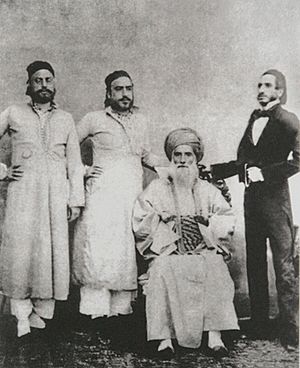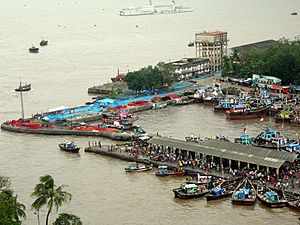- This page was last modified on 17 October 2025, at 10:18. Suggest an edit.
David Sassoon & Co. facts for kids
David Sassoon & Co., Ltd. was a famous trading company that was very active in the 1800s and early 1900s. At first, it was called David Sassoon & Sons. The company was started by David Sassoon, a businessman who was a Baghdadi Jew. The company did most of its business in India, China, and Japan, buying and selling many different kinds of goods.
Contents
The Beginning of the Company
Starting in Bombay
David Sassoon started his company in 1832 in the city of Bombay (which is now called Mumbai) in India. He began with a small office and at first focused on banking and buying property. Soon, the company grew and started trading all sorts of commodities, which are basic goods that can be bought and sold. These included:
- Precious metals
- Silks
- Gums and spices
- Wool
- Wheat
The company became very successful by specializing in trading Indian cotton yarn. The Treaty of Nanking in 1842 made it easier for companies like David Sassoon & Co. to sell these goods in China. To move their products quickly, the company used its own fast sailing ships, known as clippers.
A Global Family Business
As David Sassoon & Co. grew bigger, it opened branches in many other cities.
- In India: Calcutta and Karachi
- In China: Hongkong (in 1843), Canton, Hankow, and Shanghai (in 1845)
- In Japan: Kobe, Nagasaki, and Yokohama
- In the Middle East: Bagdad
- In the United Kingdom: London and Manchester
Like the famous Rothschilds in Europe, David Sassoon put his sons in charge of the new branches in different cities. This helped keep the business under family control. For a long time, David Sassoon was the only owner. In 1852, his son Abdallah Sassoon became a partner, and his second son, Elias David Sassoon, joined soon after.
Growth and New Directions
Leading a Trade
During the 1860s, David Sassoon & Co. became the main company in the trade between India and China.
This made them very powerful. Other big companies, like Dent & Co., went out of business.
A Family Split
In 1867, a few years after David Sassoon died, his son Elias David Sassoon left the family company. He was unhappy with his brothers and decided to start his own business, called "E.D. Sassoon & Co.". His new company also traded goods like dried fruits, tea, silk, and spices. It grew very quickly and became even larger and more successful than the original David Sassoon & Co.
Expanding into New Industries
The original company, David Sassoon & Co., also continued to grow. In 1872, it moved its main office from Bombay to London to be closer to the world's financial markets. The company also started new businesses:
- Cotton Mills: In 1874, it created the "Sassoon Spinning and Weaving Company" and opened seven large cotton mills in Bombay.
- Sassoon Docks: In 1875, the company built the Sassoon Docks in Bombay. These were the first commercial wet docks in the city, which meant ships could load and unload goods no matter how high or low the tide was. This was a huge help for trading Indian cotton with the rest of the world.
- Silk Manufacturing: In 1883, the company started making silk with its "Sassoon & Alliance Silk Mill Co. Ltd.".
The company also owned a lot of property in Hong Kong and China and acted as an agent for other businesses, like insurance companies.
Involvement in Banking
From its early days, David Sassoon & Co. was also involved in banking. The company was part of a group of British merchants that founded the "Hong Kong & Shanghai Banking Corporation" (HSBC) in 1865, which is now one of the biggest banks in the world. They also helped start the "Anglo-California Bank, Ltd." in 1873 and were a major funder of the Imperial Bank of Persia in 1889.
The 20th Century and Beyond
A New Era for the Company
After David Sassoon's son, Sir Albert Sassoon, led the company, his own son, Sir Edward Sassoon, took over. Under Sir Edward, the company officially became a Joint-stock company in 1901. This meant that for the first time, people outside the Sassoon family could own shares and be part of the company's leadership. This change was needed because of growing competition, especially from new manufacturers in Japan.
After 1907, David Sassoon & Co. slowly got out of business.
The Company's Final Years
After Sir Edward Sassoon's death in 1912, other family members and relatives ran the company. However, after the Second World War, David Sassoon & Co. was much smaller and less powerful than it had been.
In 1982, the company was sold to a London stockbroker. It was later sold again to UBS, a large bank from Switzerland. The company's businesses in Asia were then sold to Sassoon & Co, an investment company started by David Sassoon's younger brother, Joseph Sassoon. Today, the Sassoon family name continues in the business world through this separate company.
See also
- David Sassoon
- Sassoon family
- E.D. Sassoon & Co.
- List of trading companies




